MGT 101: Evaluating Unilever's Contemporary Organisational Structure
VerifiedAdded on 2024/05/27
|13
|2779
|459
Report
AI Summary
This report provides an analysis of Unilever's organisational structure, highlighting its team-based approach and its effectiveness. It begins with an introduction to team-based organizational structures and their benefits, referencing studies that support their adoption. The report then delves into Unilever's structure, which is based on product offerings (food, refreshment, personal care, and home care), supported by corporate teams (finance, HR, R&D, etc.) and geographic divisions. The analysis includes a diagrammatic representation of Unilever's structure and discusses the advantages (focus, maximum extraction, accountability, specialized knowledge, and eliminated delays) and disadvantages (clear boundaries, limitations, coordination, and flexibility) of this structure. The report concludes with suggestions for improvement, recommending the incorporation of a virtual organizational structure for certain roles and functions. Desklib provides access to this and other solved assignments.
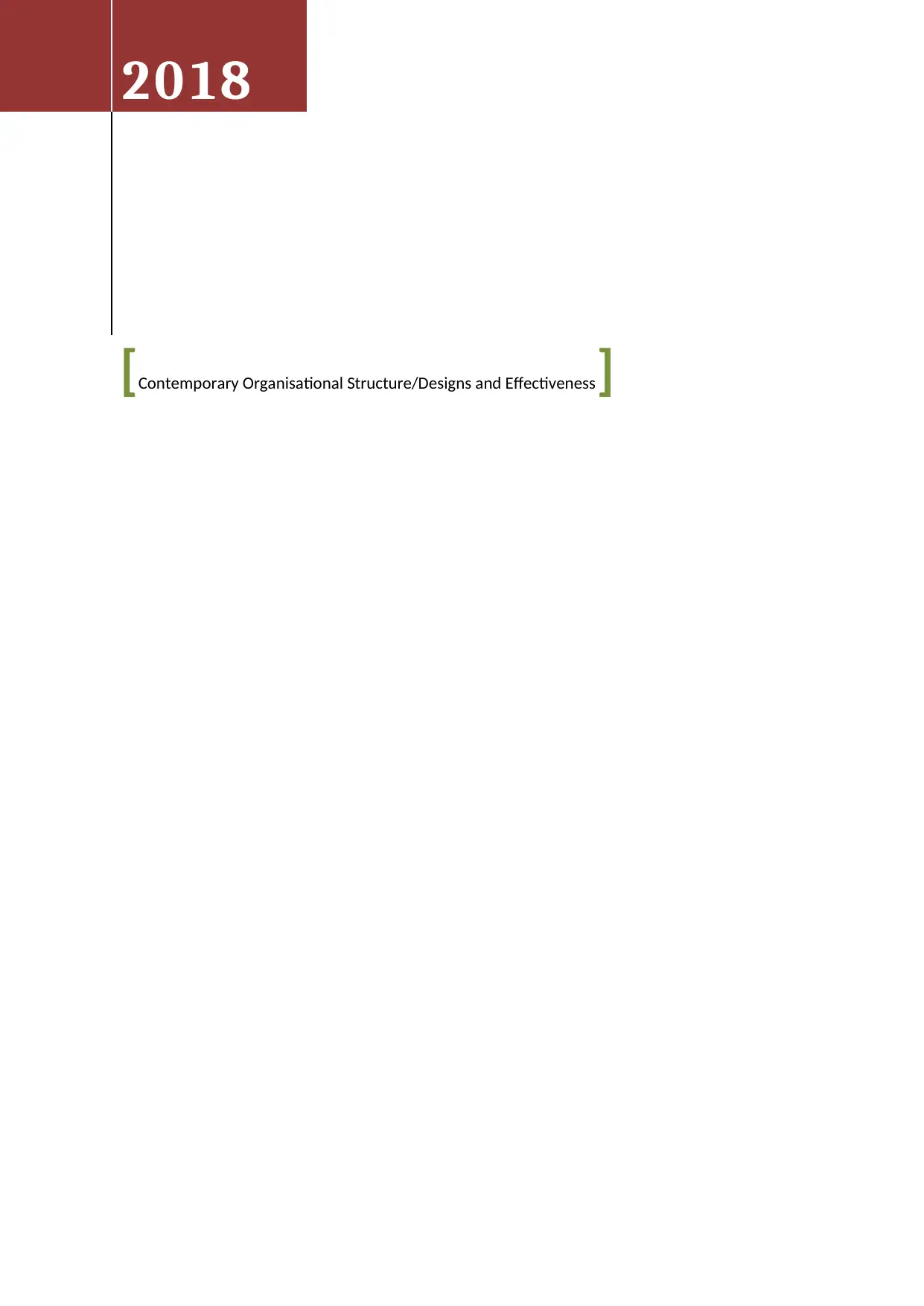
[Contemporary Organisational Structure/Designs and Effectiveness]
2018
2018
Paraphrase This Document
Need a fresh take? Get an instant paraphrase of this document with our AI Paraphraser
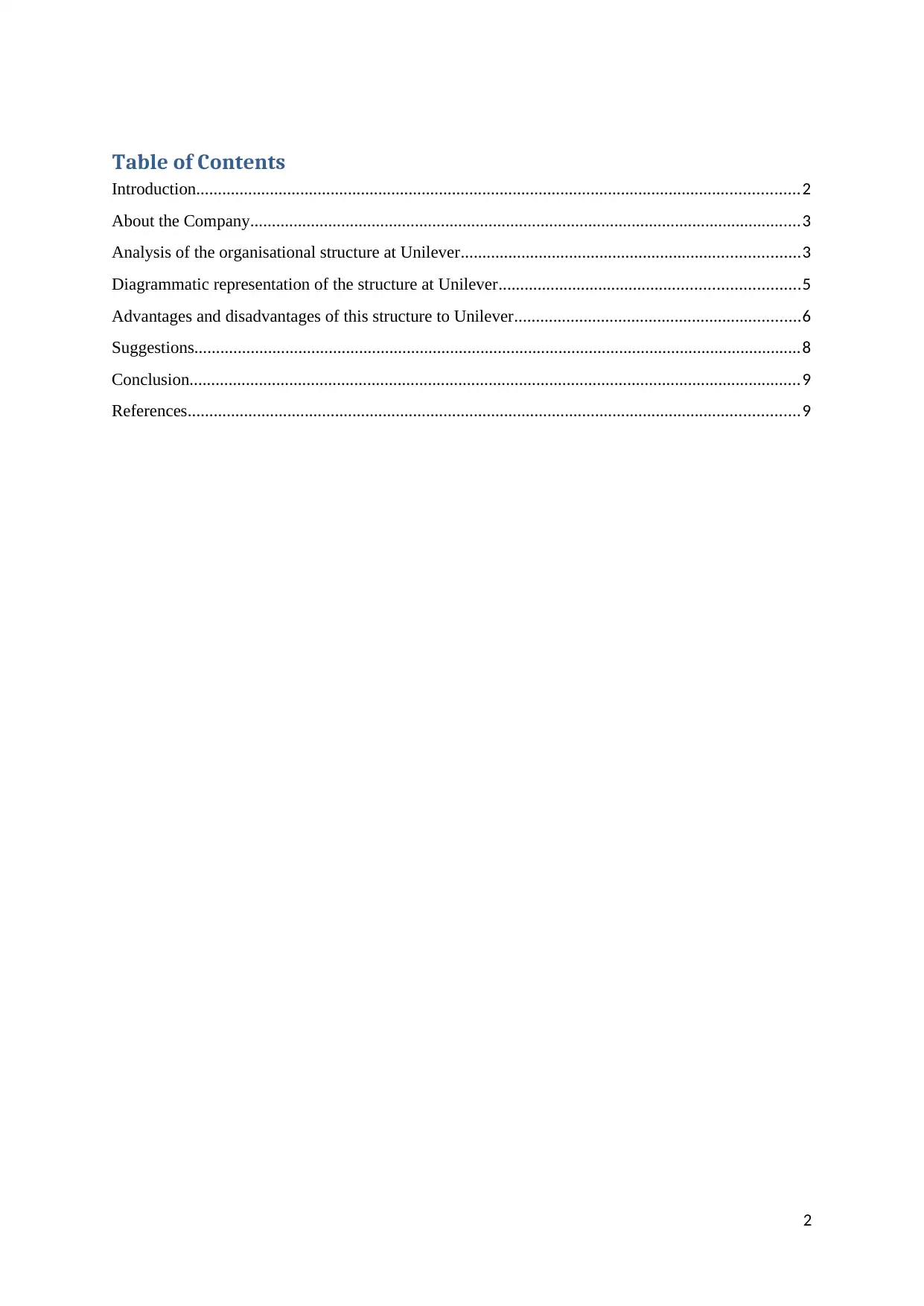
Table of Contents
Introduction...........................................................................................................................................2
About the Company...............................................................................................................................3
Analysis of the organisational structure at Unilever..............................................................................3
Diagrammatic representation of the structure at Unilever.....................................................................5
Advantages and disadvantages of this structure to Unilever..................................................................6
Suggestions............................................................................................................................................8
Conclusion.............................................................................................................................................9
References.............................................................................................................................................9
2
Introduction...........................................................................................................................................2
About the Company...............................................................................................................................3
Analysis of the organisational structure at Unilever..............................................................................3
Diagrammatic representation of the structure at Unilever.....................................................................5
Advantages and disadvantages of this structure to Unilever..................................................................6
Suggestions............................................................................................................................................8
Conclusion.............................................................................................................................................9
References.............................................................................................................................................9
2
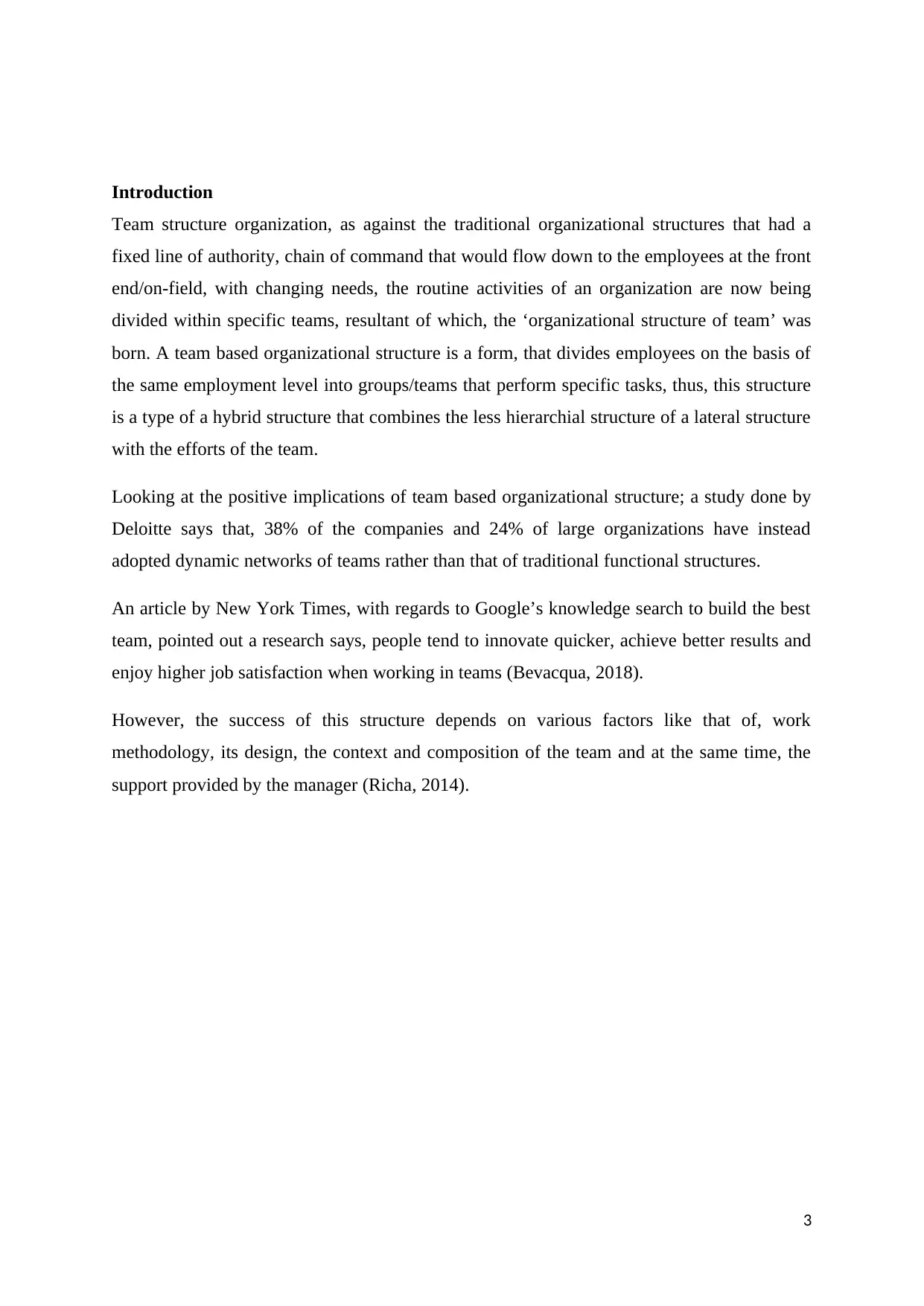
Introduction
Team structure organization, as against the traditional organizational structures that had a
fixed line of authority, chain of command that would flow down to the employees at the front
end/on-field, with changing needs, the routine activities of an organization are now being
divided within specific teams, resultant of which, the ‘organizational structure of team’ was
born. A team based organizational structure is a form, that divides employees on the basis of
the same employment level into groups/teams that perform specific tasks, thus, this structure
is a type of a hybrid structure that combines the less hierarchial structure of a lateral structure
with the efforts of the team.
Looking at the positive implications of team based organizational structure; a study done by
Deloitte says that, 38% of the companies and 24% of large organizations have instead
adopted dynamic networks of teams rather than that of traditional functional structures.
An article by New York Times, with regards to Google’s knowledge search to build the best
team, pointed out a research says, people tend to innovate quicker, achieve better results and
enjoy higher job satisfaction when working in teams (Bevacqua, 2018).
However, the success of this structure depends on various factors like that of, work
methodology, its design, the context and composition of the team and at the same time, the
support provided by the manager (Richa, 2014).
3
Team structure organization, as against the traditional organizational structures that had a
fixed line of authority, chain of command that would flow down to the employees at the front
end/on-field, with changing needs, the routine activities of an organization are now being
divided within specific teams, resultant of which, the ‘organizational structure of team’ was
born. A team based organizational structure is a form, that divides employees on the basis of
the same employment level into groups/teams that perform specific tasks, thus, this structure
is a type of a hybrid structure that combines the less hierarchial structure of a lateral structure
with the efforts of the team.
Looking at the positive implications of team based organizational structure; a study done by
Deloitte says that, 38% of the companies and 24% of large organizations have instead
adopted dynamic networks of teams rather than that of traditional functional structures.
An article by New York Times, with regards to Google’s knowledge search to build the best
team, pointed out a research says, people tend to innovate quicker, achieve better results and
enjoy higher job satisfaction when working in teams (Bevacqua, 2018).
However, the success of this structure depends on various factors like that of, work
methodology, its design, the context and composition of the team and at the same time, the
support provided by the manager (Richa, 2014).
3
⊘ This is a preview!⊘
Do you want full access?
Subscribe today to unlock all pages.

Trusted by 1+ million students worldwide
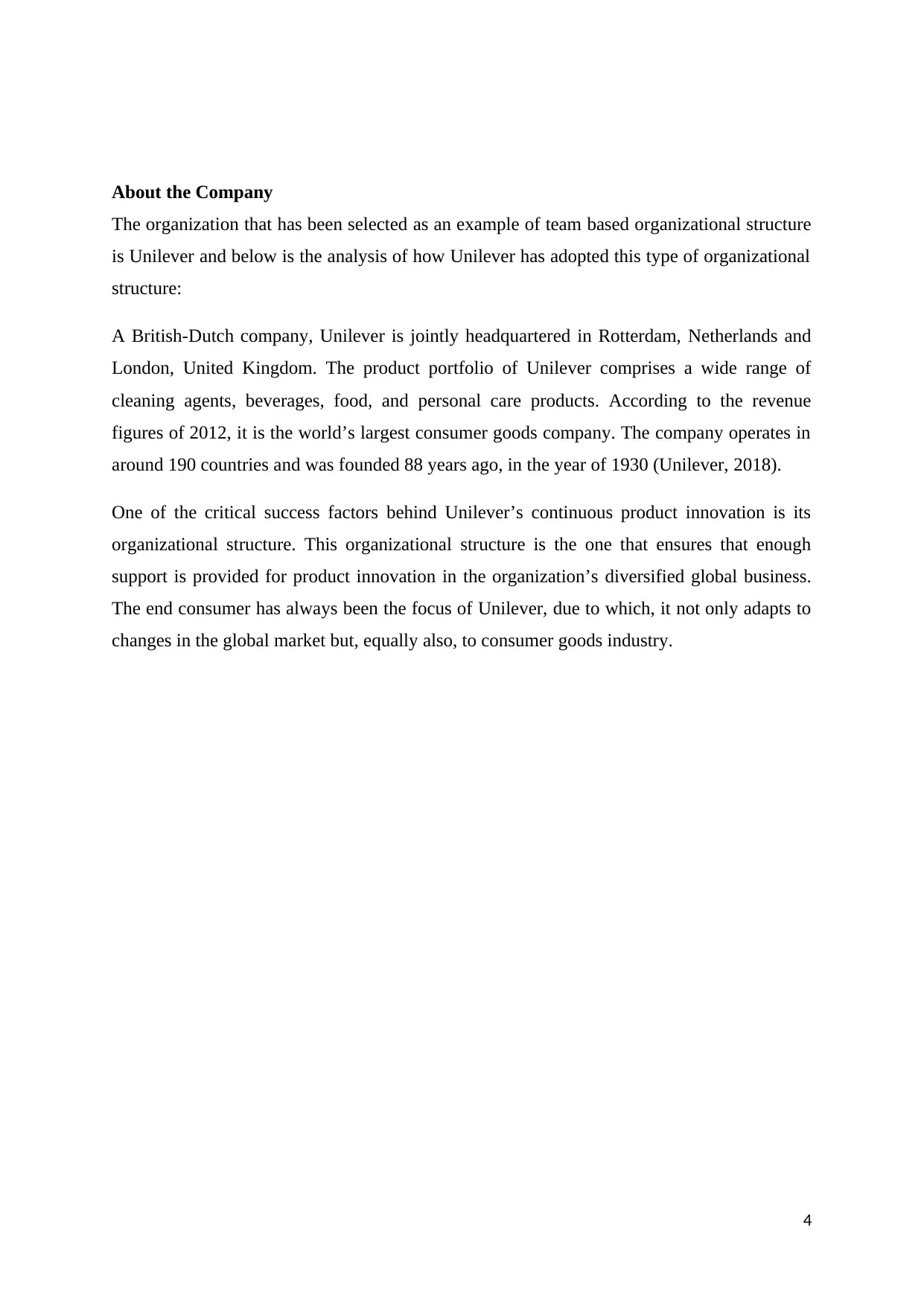
About the Company
The organization that has been selected as an example of team based organizational structure
is Unilever and below is the analysis of how Unilever has adopted this type of organizational
structure:
A British-Dutch company, Unilever is jointly headquartered in Rotterdam, Netherlands and
London, United Kingdom. The product portfolio of Unilever comprises a wide range of
cleaning agents, beverages, food, and personal care products. According to the revenue
figures of 2012, it is the world’s largest consumer goods company. The company operates in
around 190 countries and was founded 88 years ago, in the year of 1930 (Unilever, 2018).
One of the critical success factors behind Unilever’s continuous product innovation is its
organizational structure. This organizational structure is the one that ensures that enough
support is provided for product innovation in the organization’s diversified global business.
The end consumer has always been the focus of Unilever, due to which, it not only adapts to
changes in the global market but, equally also, to consumer goods industry.
4
The organization that has been selected as an example of team based organizational structure
is Unilever and below is the analysis of how Unilever has adopted this type of organizational
structure:
A British-Dutch company, Unilever is jointly headquartered in Rotterdam, Netherlands and
London, United Kingdom. The product portfolio of Unilever comprises a wide range of
cleaning agents, beverages, food, and personal care products. According to the revenue
figures of 2012, it is the world’s largest consumer goods company. The company operates in
around 190 countries and was founded 88 years ago, in the year of 1930 (Unilever, 2018).
One of the critical success factors behind Unilever’s continuous product innovation is its
organizational structure. This organizational structure is the one that ensures that enough
support is provided for product innovation in the organization’s diversified global business.
The end consumer has always been the focus of Unilever, due to which, it not only adapts to
changes in the global market but, equally also, to consumer goods industry.
4
Paraphrase This Document
Need a fresh take? Get an instant paraphrase of this document with our AI Paraphraser
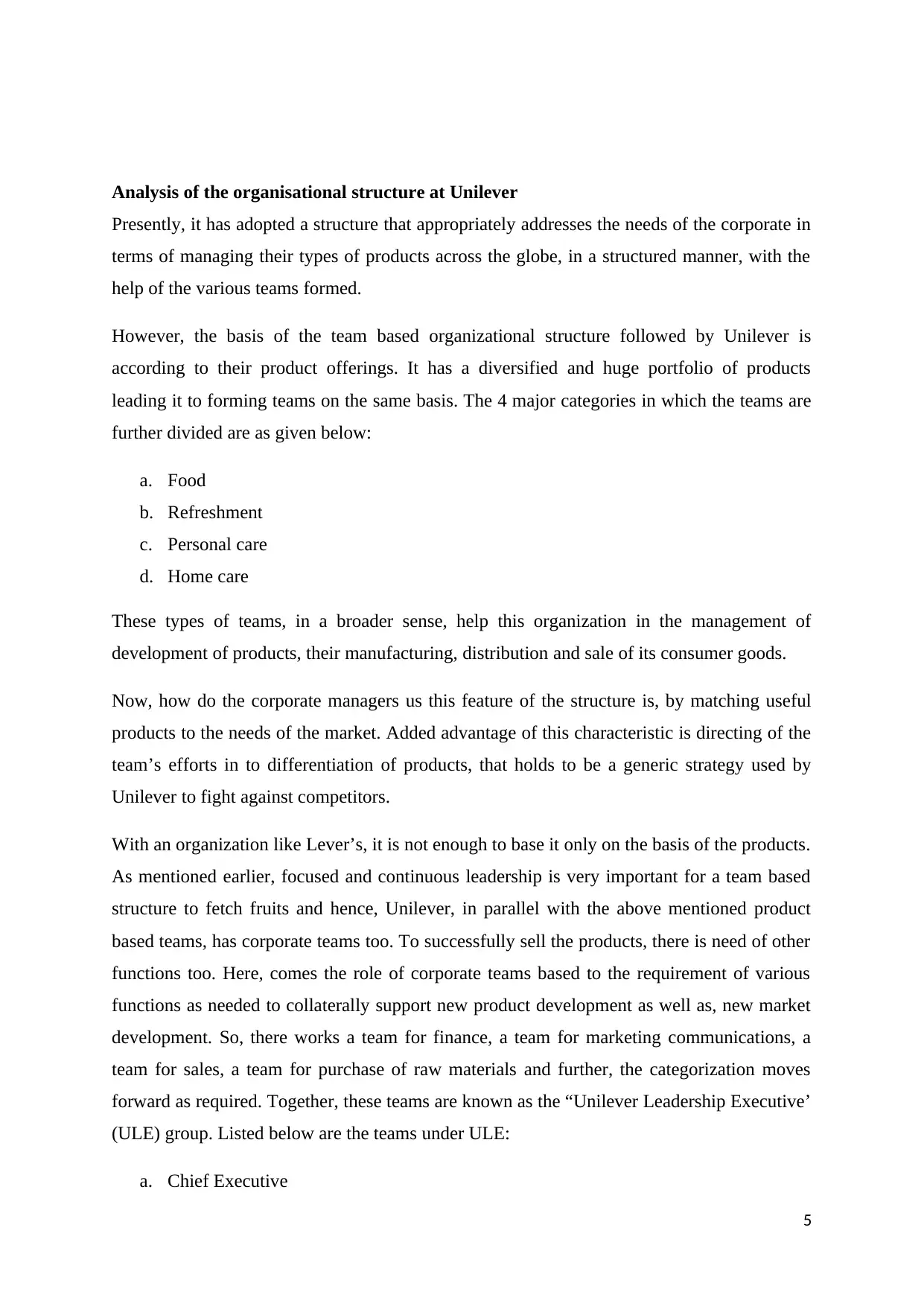
Analysis of the organisational structure at Unilever
Presently, it has adopted a structure that appropriately addresses the needs of the corporate in
terms of managing their types of products across the globe, in a structured manner, with the
help of the various teams formed.
However, the basis of the team based organizational structure followed by Unilever is
according to their product offerings. It has a diversified and huge portfolio of products
leading it to forming teams on the same basis. The 4 major categories in which the teams are
further divided are as given below:
a. Food
b. Refreshment
c. Personal care
d. Home care
These types of teams, in a broader sense, help this organization in the management of
development of products, their manufacturing, distribution and sale of its consumer goods.
Now, how do the corporate managers us this feature of the structure is, by matching useful
products to the needs of the market. Added advantage of this characteristic is directing of the
team’s efforts in to differentiation of products, that holds to be a generic strategy used by
Unilever to fight against competitors.
With an organization like Lever’s, it is not enough to base it only on the basis of the products.
As mentioned earlier, focused and continuous leadership is very important for a team based
structure to fetch fruits and hence, Unilever, in parallel with the above mentioned product
based teams, has corporate teams too. To successfully sell the products, there is need of other
functions too. Here, comes the role of corporate teams based to the requirement of various
functions as needed to collaterally support new product development as well as, new market
development. So, there works a team for finance, a team for marketing communications, a
team for sales, a team for purchase of raw materials and further, the categorization moves
forward as required. Together, these teams are known as the “Unilever Leadership Executive’
(ULE) group. Listed below are the teams under ULE:
a. Chief Executive
5
Presently, it has adopted a structure that appropriately addresses the needs of the corporate in
terms of managing their types of products across the globe, in a structured manner, with the
help of the various teams formed.
However, the basis of the team based organizational structure followed by Unilever is
according to their product offerings. It has a diversified and huge portfolio of products
leading it to forming teams on the same basis. The 4 major categories in which the teams are
further divided are as given below:
a. Food
b. Refreshment
c. Personal care
d. Home care
These types of teams, in a broader sense, help this organization in the management of
development of products, their manufacturing, distribution and sale of its consumer goods.
Now, how do the corporate managers us this feature of the structure is, by matching useful
products to the needs of the market. Added advantage of this characteristic is directing of the
team’s efforts in to differentiation of products, that holds to be a generic strategy used by
Unilever to fight against competitors.
With an organization like Lever’s, it is not enough to base it only on the basis of the products.
As mentioned earlier, focused and continuous leadership is very important for a team based
structure to fetch fruits and hence, Unilever, in parallel with the above mentioned product
based teams, has corporate teams too. To successfully sell the products, there is need of other
functions too. Here, comes the role of corporate teams based to the requirement of various
functions as needed to collaterally support new product development as well as, new market
development. So, there works a team for finance, a team for marketing communications, a
team for sales, a team for purchase of raw materials and further, the categorization moves
forward as required. Together, these teams are known as the “Unilever Leadership Executive’
(ULE) group. Listed below are the teams under ULE:
a. Chief Executive
5
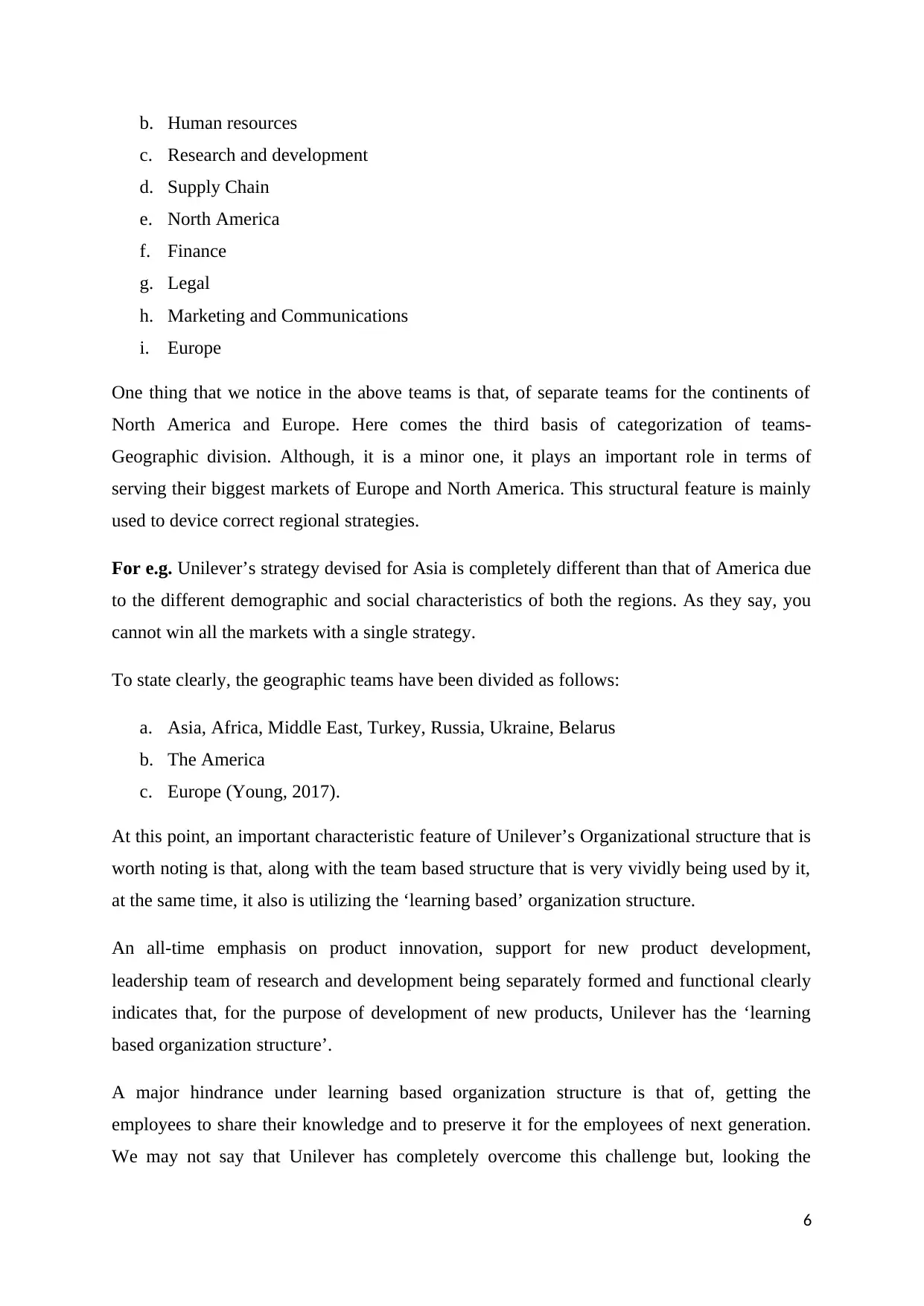
b. Human resources
c. Research and development
d. Supply Chain
e. North America
f. Finance
g. Legal
h. Marketing and Communications
i. Europe
One thing that we notice in the above teams is that, of separate teams for the continents of
North America and Europe. Here comes the third basis of categorization of teams-
Geographic division. Although, it is a minor one, it plays an important role in terms of
serving their biggest markets of Europe and North America. This structural feature is mainly
used to device correct regional strategies.
For e.g. Unilever’s strategy devised for Asia is completely different than that of America due
to the different demographic and social characteristics of both the regions. As they say, you
cannot win all the markets with a single strategy.
To state clearly, the geographic teams have been divided as follows:
a. Asia, Africa, Middle East, Turkey, Russia, Ukraine, Belarus
b. The America
c. Europe (Young, 2017).
At this point, an important characteristic feature of Unilever’s Organizational structure that is
worth noting is that, along with the team based structure that is very vividly being used by it,
at the same time, it also is utilizing the ‘learning based’ organization structure.
An all-time emphasis on product innovation, support for new product development,
leadership team of research and development being separately formed and functional clearly
indicates that, for the purpose of development of new products, Unilever has the ‘learning
based organization structure’.
A major hindrance under learning based organization structure is that of, getting the
employees to share their knowledge and to preserve it for the employees of next generation.
We may not say that Unilever has completely overcome this challenge but, looking the
6
c. Research and development
d. Supply Chain
e. North America
f. Finance
g. Legal
h. Marketing and Communications
i. Europe
One thing that we notice in the above teams is that, of separate teams for the continents of
North America and Europe. Here comes the third basis of categorization of teams-
Geographic division. Although, it is a minor one, it plays an important role in terms of
serving their biggest markets of Europe and North America. This structural feature is mainly
used to device correct regional strategies.
For e.g. Unilever’s strategy devised for Asia is completely different than that of America due
to the different demographic and social characteristics of both the regions. As they say, you
cannot win all the markets with a single strategy.
To state clearly, the geographic teams have been divided as follows:
a. Asia, Africa, Middle East, Turkey, Russia, Ukraine, Belarus
b. The America
c. Europe (Young, 2017).
At this point, an important characteristic feature of Unilever’s Organizational structure that is
worth noting is that, along with the team based structure that is very vividly being used by it,
at the same time, it also is utilizing the ‘learning based’ organization structure.
An all-time emphasis on product innovation, support for new product development,
leadership team of research and development being separately formed and functional clearly
indicates that, for the purpose of development of new products, Unilever has the ‘learning
based organization structure’.
A major hindrance under learning based organization structure is that of, getting the
employees to share their knowledge and to preserve it for the employees of next generation.
We may not say that Unilever has completely overcome this challenge but, looking the
6
⊘ This is a preview!⊘
Do you want full access?
Subscribe today to unlock all pages.

Trusted by 1+ million students worldwide
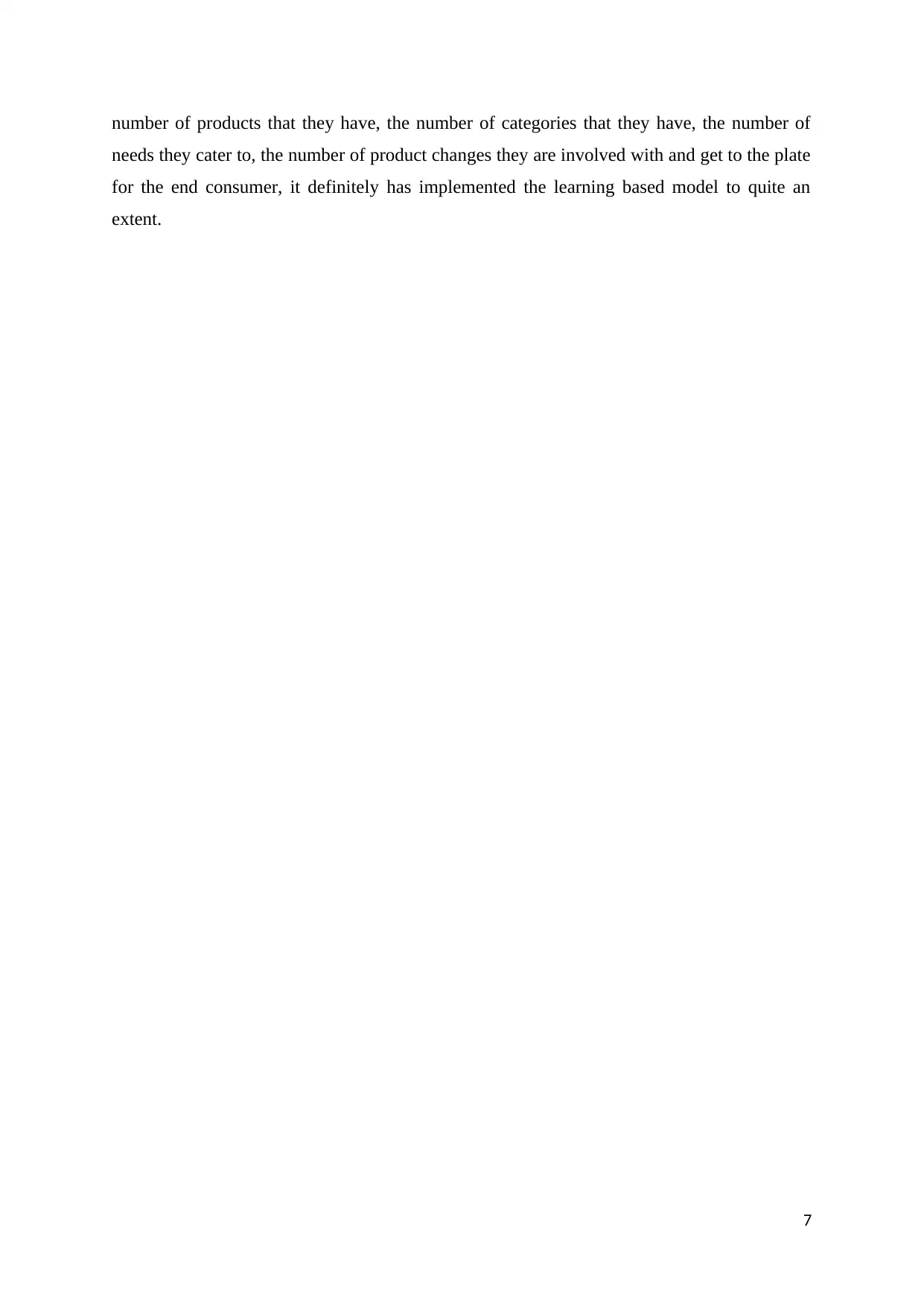
number of products that they have, the number of categories that they have, the number of
needs they cater to, the number of product changes they are involved with and get to the plate
for the end consumer, it definitely has implemented the learning based model to quite an
extent.
7
needs they cater to, the number of product changes they are involved with and get to the plate
for the end consumer, it definitely has implemented the learning based model to quite an
extent.
7
Paraphrase This Document
Need a fresh take? Get an instant paraphrase of this document with our AI Paraphraser
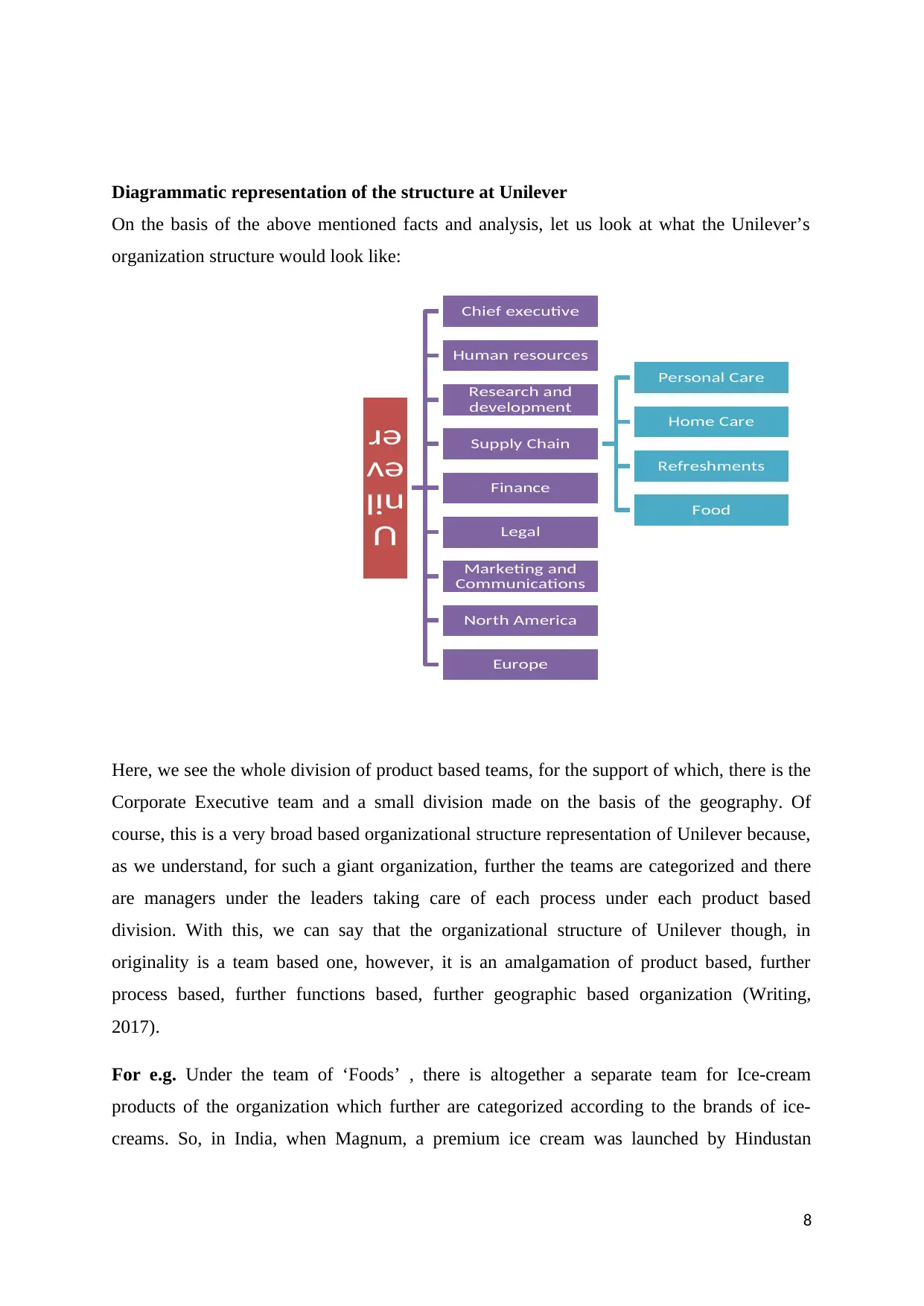
Diagrammatic representation of the structure at Unilever
On the basis of the above mentioned facts and analysis, let us look at what the Unilever’s
organization structure would look like:
Here, we see the whole division of product based teams, for the support of which, there is the
Corporate Executive team and a small division made on the basis of the geography. Of
course, this is a very broad based organizational structure representation of Unilever because,
as we understand, for such a giant organization, further the teams are categorized and there
are managers under the leaders taking care of each process under each product based
division. With this, we can say that the organizational structure of Unilever though, in
originality is a team based one, however, it is an amalgamation of product based, further
process based, further functions based, further geographic based organization (Writing,
2017).
For e.g. Under the team of ‘Foods’ , there is altogether a separate team for Ice-cream
products of the organization which further are categorized according to the brands of ice-
creams. So, in India, when Magnum, a premium ice cream was launched by Hindustan
8
U
nil
ev
er
Chief executive
Human resources
Research and
development
Supply Chain
Personal Care
Home Care
Refreshments
Food
Finance
Legal
Marketing and
Communications
North America
Europe
On the basis of the above mentioned facts and analysis, let us look at what the Unilever’s
organization structure would look like:
Here, we see the whole division of product based teams, for the support of which, there is the
Corporate Executive team and a small division made on the basis of the geography. Of
course, this is a very broad based organizational structure representation of Unilever because,
as we understand, for such a giant organization, further the teams are categorized and there
are managers under the leaders taking care of each process under each product based
division. With this, we can say that the organizational structure of Unilever though, in
originality is a team based one, however, it is an amalgamation of product based, further
process based, further functions based, further geographic based organization (Writing,
2017).
For e.g. Under the team of ‘Foods’ , there is altogether a separate team for Ice-cream
products of the organization which further are categorized according to the brands of ice-
creams. So, in India, when Magnum, a premium ice cream was launched by Hindustan
8
U
nil
ev
er
Chief executive
Human resources
Research and
development
Supply Chain
Personal Care
Home Care
Refreshments
Food
Finance
Legal
Marketing and
Communications
North America
Europe
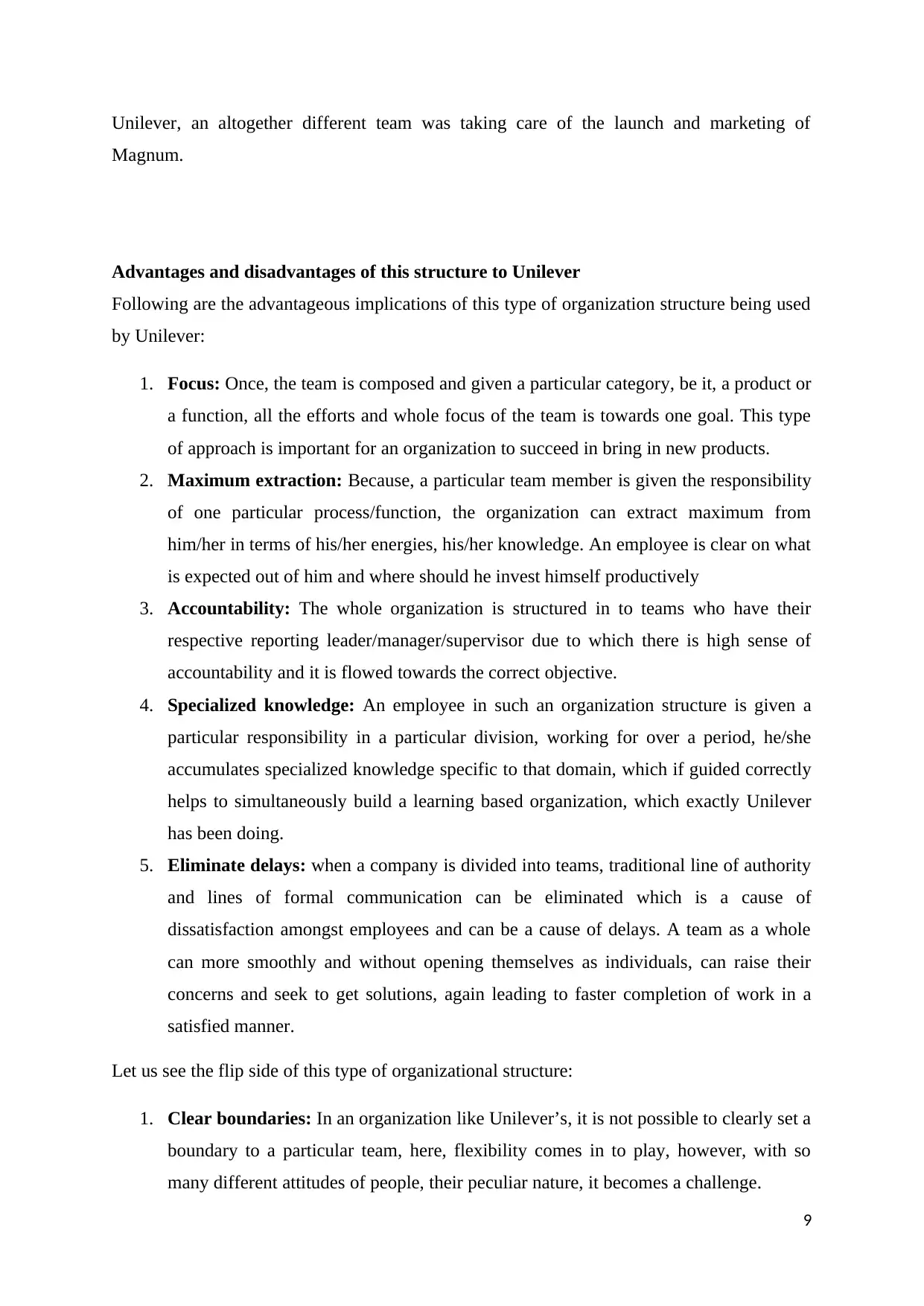
Unilever, an altogether different team was taking care of the launch and marketing of
Magnum.
Advantages and disadvantages of this structure to Unilever
Following are the advantageous implications of this type of organization structure being used
by Unilever:
1. Focus: Once, the team is composed and given a particular category, be it, a product or
a function, all the efforts and whole focus of the team is towards one goal. This type
of approach is important for an organization to succeed in bring in new products.
2. Maximum extraction: Because, a particular team member is given the responsibility
of one particular process/function, the organization can extract maximum from
him/her in terms of his/her energies, his/her knowledge. An employee is clear on what
is expected out of him and where should he invest himself productively
3. Accountability: The whole organization is structured in to teams who have their
respective reporting leader/manager/supervisor due to which there is high sense of
accountability and it is flowed towards the correct objective.
4. Specialized knowledge: An employee in such an organization structure is given a
particular responsibility in a particular division, working for over a period, he/she
accumulates specialized knowledge specific to that domain, which if guided correctly
helps to simultaneously build a learning based organization, which exactly Unilever
has been doing.
5. Eliminate delays: when a company is divided into teams, traditional line of authority
and lines of formal communication can be eliminated which is a cause of
dissatisfaction amongst employees and can be a cause of delays. A team as a whole
can more smoothly and without opening themselves as individuals, can raise their
concerns and seek to get solutions, again leading to faster completion of work in a
satisfied manner.
Let us see the flip side of this type of organizational structure:
1. Clear boundaries: In an organization like Unilever’s, it is not possible to clearly set a
boundary to a particular team, here, flexibility comes in to play, however, with so
many different attitudes of people, their peculiar nature, it becomes a challenge.
9
Magnum.
Advantages and disadvantages of this structure to Unilever
Following are the advantageous implications of this type of organization structure being used
by Unilever:
1. Focus: Once, the team is composed and given a particular category, be it, a product or
a function, all the efforts and whole focus of the team is towards one goal. This type
of approach is important for an organization to succeed in bring in new products.
2. Maximum extraction: Because, a particular team member is given the responsibility
of one particular process/function, the organization can extract maximum from
him/her in terms of his/her energies, his/her knowledge. An employee is clear on what
is expected out of him and where should he invest himself productively
3. Accountability: The whole organization is structured in to teams who have their
respective reporting leader/manager/supervisor due to which there is high sense of
accountability and it is flowed towards the correct objective.
4. Specialized knowledge: An employee in such an organization structure is given a
particular responsibility in a particular division, working for over a period, he/she
accumulates specialized knowledge specific to that domain, which if guided correctly
helps to simultaneously build a learning based organization, which exactly Unilever
has been doing.
5. Eliminate delays: when a company is divided into teams, traditional line of authority
and lines of formal communication can be eliminated which is a cause of
dissatisfaction amongst employees and can be a cause of delays. A team as a whole
can more smoothly and without opening themselves as individuals, can raise their
concerns and seek to get solutions, again leading to faster completion of work in a
satisfied manner.
Let us see the flip side of this type of organizational structure:
1. Clear boundaries: In an organization like Unilever’s, it is not possible to clearly set a
boundary to a particular team, here, flexibility comes in to play, however, with so
many different attitudes of people, their peculiar nature, it becomes a challenge.
9
⊘ This is a preview!⊘
Do you want full access?
Subscribe today to unlock all pages.

Trusted by 1+ million students worldwide
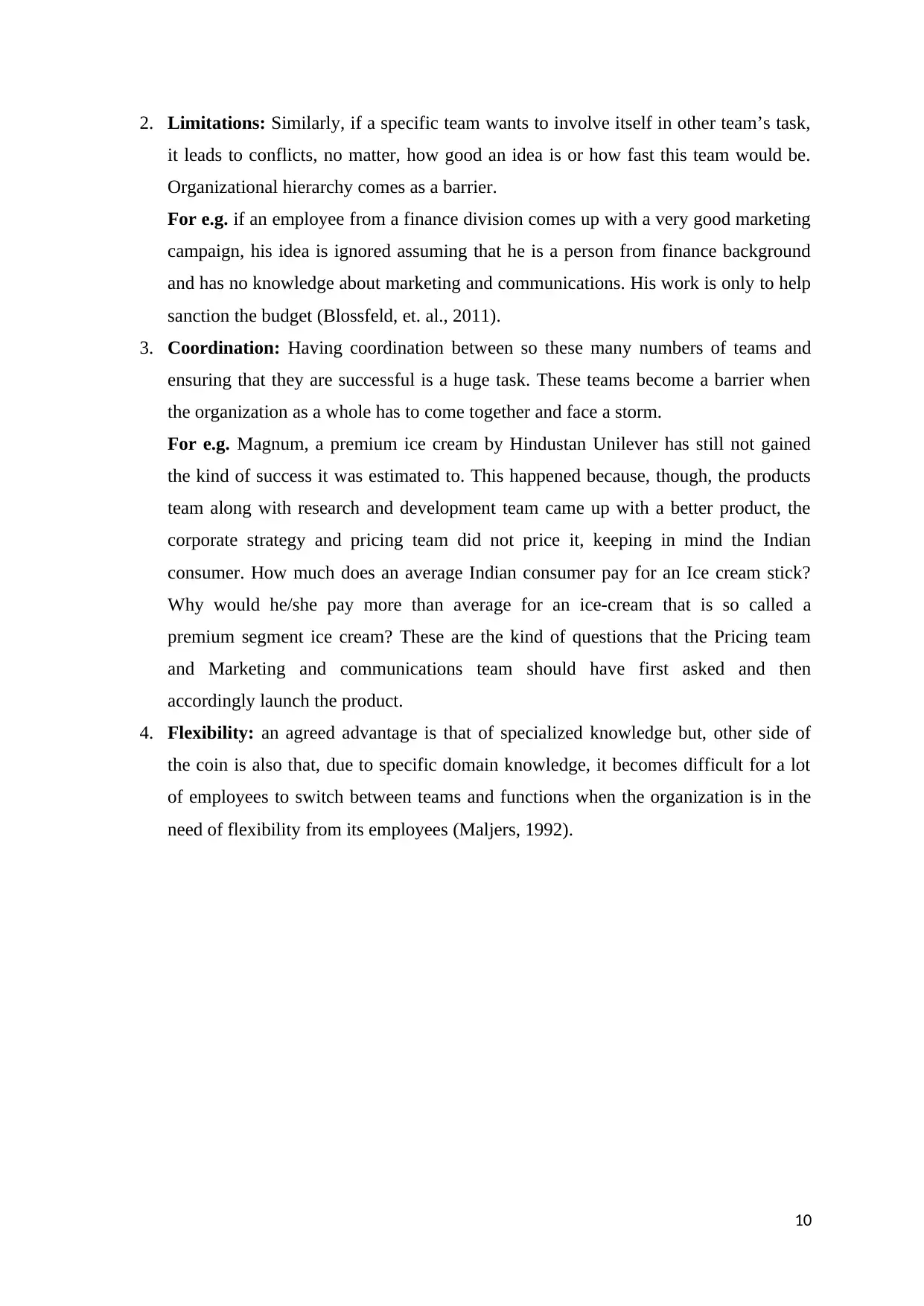
2. Limitations: Similarly, if a specific team wants to involve itself in other team’s task,
it leads to conflicts, no matter, how good an idea is or how fast this team would be.
Organizational hierarchy comes as a barrier.
For e.g. if an employee from a finance division comes up with a very good marketing
campaign, his idea is ignored assuming that he is a person from finance background
and has no knowledge about marketing and communications. His work is only to help
sanction the budget (Blossfeld, et. al., 2011).
3. Coordination: Having coordination between so these many numbers of teams and
ensuring that they are successful is a huge task. These teams become a barrier when
the organization as a whole has to come together and face a storm.
For e.g. Magnum, a premium ice cream by Hindustan Unilever has still not gained
the kind of success it was estimated to. This happened because, though, the products
team along with research and development team came up with a better product, the
corporate strategy and pricing team did not price it, keeping in mind the Indian
consumer. How much does an average Indian consumer pay for an Ice cream stick?
Why would he/she pay more than average for an ice-cream that is so called a
premium segment ice cream? These are the kind of questions that the Pricing team
and Marketing and communications team should have first asked and then
accordingly launch the product.
4. Flexibility: an agreed advantage is that of specialized knowledge but, other side of
the coin is also that, due to specific domain knowledge, it becomes difficult for a lot
of employees to switch between teams and functions when the organization is in the
need of flexibility from its employees (Maljers, 1992).
10
it leads to conflicts, no matter, how good an idea is or how fast this team would be.
Organizational hierarchy comes as a barrier.
For e.g. if an employee from a finance division comes up with a very good marketing
campaign, his idea is ignored assuming that he is a person from finance background
and has no knowledge about marketing and communications. His work is only to help
sanction the budget (Blossfeld, et. al., 2011).
3. Coordination: Having coordination between so these many numbers of teams and
ensuring that they are successful is a huge task. These teams become a barrier when
the organization as a whole has to come together and face a storm.
For e.g. Magnum, a premium ice cream by Hindustan Unilever has still not gained
the kind of success it was estimated to. This happened because, though, the products
team along with research and development team came up with a better product, the
corporate strategy and pricing team did not price it, keeping in mind the Indian
consumer. How much does an average Indian consumer pay for an Ice cream stick?
Why would he/she pay more than average for an ice-cream that is so called a
premium segment ice cream? These are the kind of questions that the Pricing team
and Marketing and communications team should have first asked and then
accordingly launch the product.
4. Flexibility: an agreed advantage is that of specialized knowledge but, other side of
the coin is also that, due to specific domain knowledge, it becomes difficult for a lot
of employees to switch between teams and functions when the organization is in the
need of flexibility from its employees (Maljers, 1992).
10
Paraphrase This Document
Need a fresh take? Get an instant paraphrase of this document with our AI Paraphraser
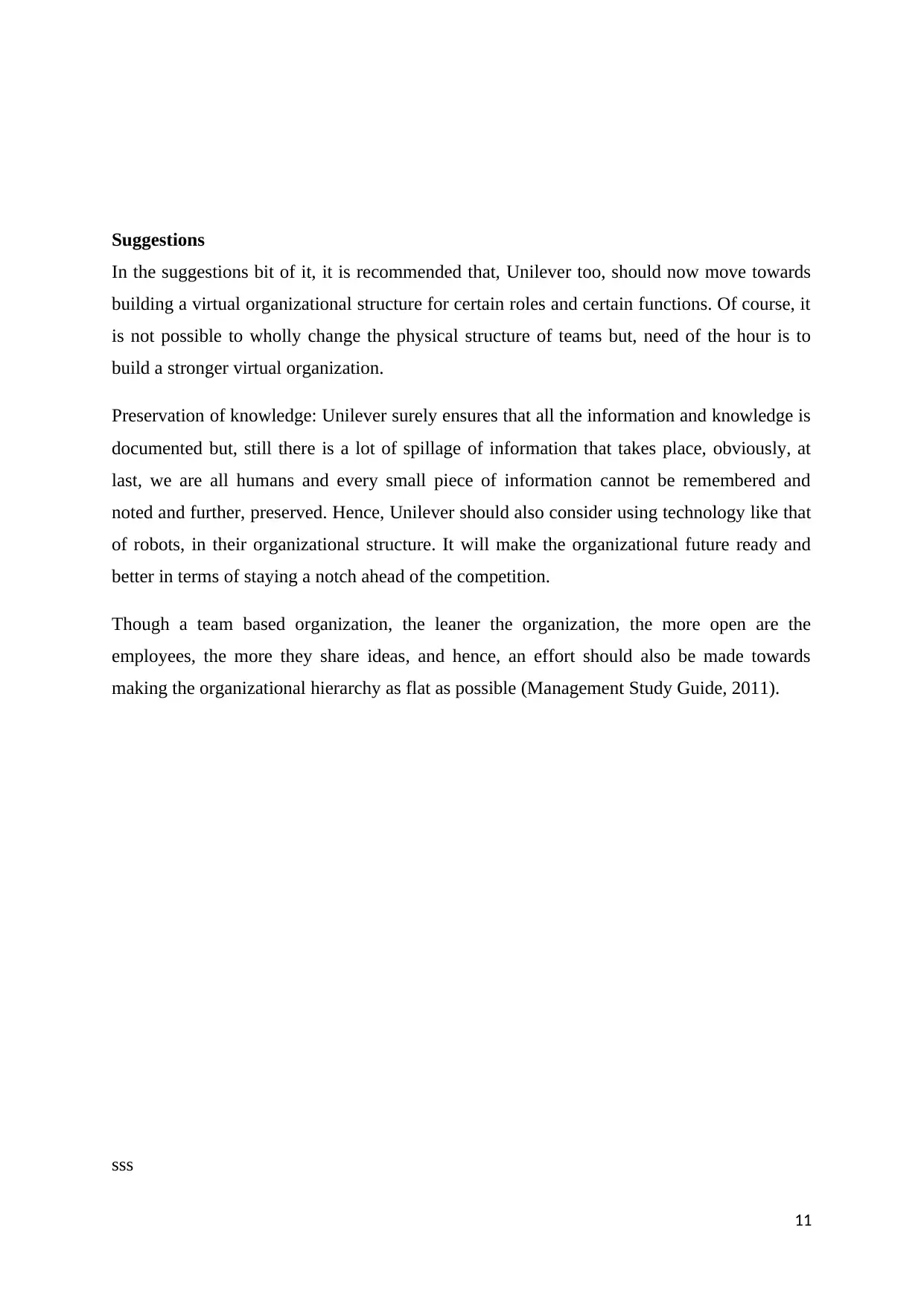
Suggestions
In the suggestions bit of it, it is recommended that, Unilever too, should now move towards
building a virtual organizational structure for certain roles and certain functions. Of course, it
is not possible to wholly change the physical structure of teams but, need of the hour is to
build a stronger virtual organization.
Preservation of knowledge: Unilever surely ensures that all the information and knowledge is
documented but, still there is a lot of spillage of information that takes place, obviously, at
last, we are all humans and every small piece of information cannot be remembered and
noted and further, preserved. Hence, Unilever should also consider using technology like that
of robots, in their organizational structure. It will make the organizational future ready and
better in terms of staying a notch ahead of the competition.
Though a team based organization, the leaner the organization, the more open are the
employees, the more they share ideas, and hence, an effort should also be made towards
making the organizational hierarchy as flat as possible (Management Study Guide, 2011).
sss
11
In the suggestions bit of it, it is recommended that, Unilever too, should now move towards
building a virtual organizational structure for certain roles and certain functions. Of course, it
is not possible to wholly change the physical structure of teams but, need of the hour is to
build a stronger virtual organization.
Preservation of knowledge: Unilever surely ensures that all the information and knowledge is
documented but, still there is a lot of spillage of information that takes place, obviously, at
last, we are all humans and every small piece of information cannot be remembered and
noted and further, preserved. Hence, Unilever should also consider using technology like that
of robots, in their organizational structure. It will make the organizational future ready and
better in terms of staying a notch ahead of the competition.
Though a team based organization, the leaner the organization, the more open are the
employees, the more they share ideas, and hence, an effort should also be made towards
making the organizational hierarchy as flat as possible (Management Study Guide, 2011).
sss
11
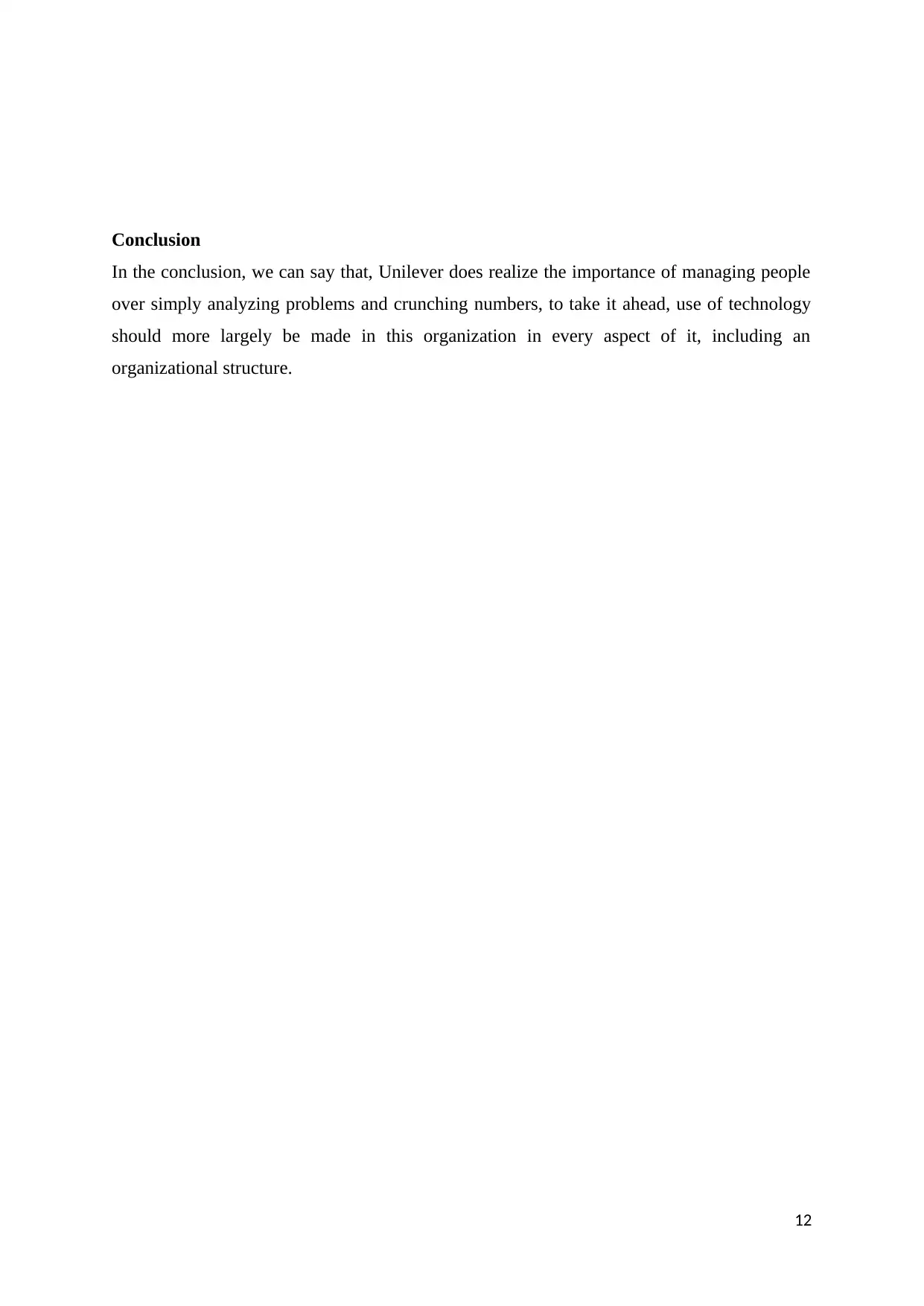
Conclusion
In the conclusion, we can say that, Unilever does realize the importance of managing people
over simply analyzing problems and crunching numbers, to take it ahead, use of technology
should more largely be made in this organization in every aspect of it, including an
organizational structure.
12
In the conclusion, we can say that, Unilever does realize the importance of managing people
over simply analyzing problems and crunching numbers, to take it ahead, use of technology
should more largely be made in this organization in every aspect of it, including an
organizational structure.
12
⊘ This is a preview!⊘
Do you want full access?
Subscribe today to unlock all pages.

Trusted by 1+ million students worldwide
1 out of 13
Related Documents
Your All-in-One AI-Powered Toolkit for Academic Success.
+13062052269
info@desklib.com
Available 24*7 on WhatsApp / Email
![[object Object]](/_next/static/media/star-bottom.7253800d.svg)
Unlock your academic potential
Copyright © 2020–2025 A2Z Services. All Rights Reserved. Developed and managed by ZUCOL.





